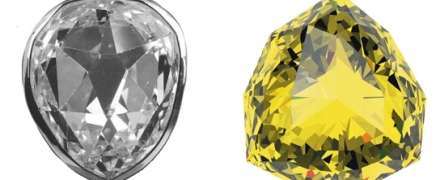open 10 am - 7 pm
laboratory is closed
Old brilliant cut "Rose" ("Old Rose cut")

This type of cut was first used in India, which was the only source of gem-quality diamonds throughout the ancient, antique and medieval periods of history. Initially, such a shape was obtained by diamonds or their fragments with a wide development of dodecahedral shapes during the finishing of flat surfaces of the facets by polishing. Later, in the early Middle Ages, this type of cutting began to be used for stones with isometric outlines, giving the curved surface the appearance of a combination of many flat faces of a predominantly triangular shape. Later, this type of cutting was adopted by European craftsmen. One of the first European diamond cutters whose name has come down to us was the Fleming Lodewyk / Lodewijk van Berquem from Bruges, who worked in Antwerp. The first mention of his "new" method of cutting diamonds dates back to 1456. Later, in the 1470s, he was patronized by the Duke of Burgundy Charles the Bold (Charles le Téméraire, 1433-1477), for whom in 1473 a "pandel"-shaped diamond was made, worn on the knightly helmet of the duke and according to one of the legends is a diamond with the Sancy diamond. In addition to him, the Florentine diamond was cut in the form of "Old Rose" for Karl the Bold, which was subsequently re-cut. Later, both stones were lost during the robbery of the duke.
Over time, the Rose cut has been improved, and its multiple varieties have also appeared. The most famous stone with this type of cut is the Orlov diamond, installed in the Russian Imperial scepter. It can be seen at the exhibition of the Diamond Fund in the Moscow Kremlin.
В геммологической практике бывают весьма увлекательные случаи с диагностикой ювелирных вставок
Но помимо редкости цвета и высокой стоимости таких камней, многие розовые камни выделяются одной замечательной особенностью – они проявляют плеохроизм, то есть в зависимости от положения осмотра камня он может иметь дополнительные оттенки – оранжевый или пурпурный.
Currently, gemstones are produced by two fundamentally different technological methods - the High Pressure - High Temperature method (“HPHT”, High-pressure & High-temperature) and the Chemical Vapor Deposition (“CVD”, Chemical vapor deposition) method. The "HPHT" method is the most tested classical synthesis method, which can be used both carbon deposition on diamond from flux melts and catalytic reactions. In "CVD" synthesis, diamond growth occurs on a seed during carbon deposition mainly from a gaseous medium at relatively low temperatures and pressures.
Jewelry and precious stones are just such a category of goods, when buying which you need to pay attention to many criteria.
Sogdianite is a rather rare mineral and more often it can be found as a collection material (moreover, in systematic collections), and it is extremely rare in jewelry.






